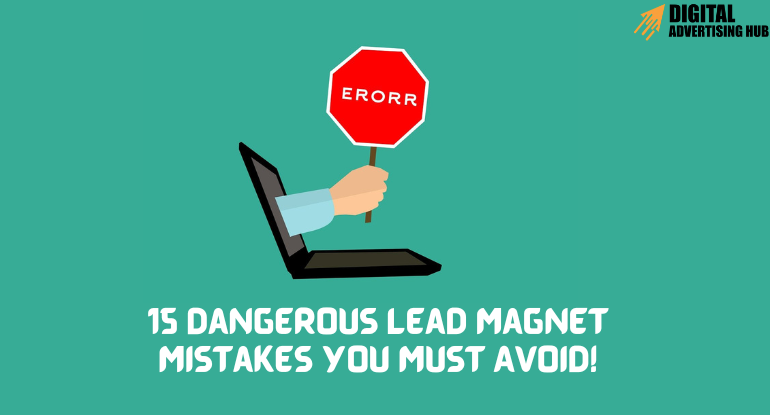In my years as a digital marketer, I have fielded a number of inquiries. Among them are; What constitutes a good lead magnet? Why is there a lag in conversions? What distinguishes a lead magnet that works well from one that doesn’t?
Lead magnets are still a vital lead generating tactic, as I’m sure you would agree. But these effective techniques can occasionally perform worse, even for seasoned marketers.
I have taken my time to compile a list of the top 15 lead magnet errors that I have observed during my professional experience. You can maximize the effectiveness of your lead magnets to successfully attract and engage your target audience by being aware of these common mistakes and how to avoid them. You will have the information from this post to turn your lead magnets into conversion-driving devices.
15 Common Lead Magnet Mistakes

Lead magnets are those engaging content pieces that are provided in return for important user data. They are an essential part of the toolkit for every digital marketer. Lead magnets have a lot of promise, but occasionally they don’t work as expected, leaving marketers puzzled about what went wrong.
The top 15 faults that might reduce your lead magnet’s efficacy are listed in this section. You can prevent these mistakes by being aware of them in advance and making sure your lead magnets are positioned to draw in, hold on to, and convert your target audience.
Here, we’ll break down each error in-depth and offer concise justifications and useful advice to assist you in creating lead magnets that live up to your expectations.
#1. Ignoring Who You Are Reaching
An effective lead magnet starts with a thorough grasp of your target market. Making a general lead magnet that aims to appeal to a wide range of individuals is a typical error, though. It’s unlikely that anyone will be very receptive to this disorganized approach.
Consider providing a lead magnet entitled “The Ultimate Guide to Marketing” to each and every website visitor. A novice entrepreneur could find this wide topic interesting, but an experienced marketing expert might find it too general.
How can you fix the mistake?

You must narrow your target down to your ideal client in order to create an engaging lead magnet. Determine the unique obstacles they have and design your content to specifically address those problems. One potential lead magnet for small company owners might be “The Local SEO Checklist for Getting Found Online.” This provides a clear answer while immediately addressing a problem that your target audience is facing.
By designing customized lead magnets, you show that you have a thorough grasp of your audience’s requirements, building credibility and raising conversion rates.
#2. Providing the Inappropriate Content
Making the incorrect format choice for your lead magnet is another error, even if you have already determined who your target market is. Even while eBooks can be very educational, they might not be the best choice for someone looking for rapid, practical advice. In a similar vein, a webinar might not be the best format for a busy person.
Recognizing the Preferences of Your Audience
The secret to success is to match the demands and preferences of your audience with the format of the material. Take into account these elements:
#1. Time Commitment: Do your ideal clients have more time to devote to learning, or are they harried professionals looking for rapid wins?
#2. Learning Style: Are they more interested in interactive features like quizzes, detailed written information, or visual aids like infographics?
#3. Tech Savvy: Would your target audience rather download a PDF or take an online course or webinar?
You may select the format that best fits the learning preferences and time limits of your audience by taking these factors into account.
The following techniques can help reveal their preferred material format, time limitations, and learning style:
#1. Conducting Surveys: One of the most effective ways to receive direct feedback from the audience is to create a brief survey with focused questions. Inquire about their preferred learning modes (visual, aural, or kinesthetic), preferred content types (e.g., eBooks, checklists, infographics), and the amount of time they typically spend consuming material.
#2. Website Analytics: Make use of these technologies to gain insight into the behavior of your audience. Check out which blog entries people spend the most time on (long pieces or brief advice?) and what kinds of material (infographics, videos, etc.) get the most interaction. This information offers insightful information on how they like to consume information.
#3. Social Media Engagement: Examine how your social media followers respond to various kinds of material. View the text, image, and video posts that receive the most likes, shares, and comments. This may disclose their favored social media content type, which may also indicate their preferences for lead magnets.
#4. Customer consultations: Interview a select group of people from your target market in-depth. Inquire open-endedly about their difficulties, favored methods of learning, and schedule limitations. These interviews offer insightful qualitative information that will help you choose the best lead magnet format.
You may get a complete picture of your audience’s preferences by combining these techniques. With the use of this information, you can select the ideal format for your lead magnet to make sure it appeals to and maximizes your target demographic.
#3. Ignoring a Particular Pain Point: Not Meeting the Needs of the Audience

The efficacy of a lead magnet is contingent upon its capacity to address a legitimate issue faced by your intended audience. Nonetheless, providing general information that ignores a particular pain issue is a typical error.
Consider providing a lead magnet with the title “10 Marketing Tips” but no further explanation. It may seem useful, but it’s not going to get much attention. Given the variety of marketing obstacles your audience is probably dealing with, a long list of suggestions might not address their top issue.
Focusing on Particular Pain Points to Get the Most Impact
Identify the particular difficulties that your potential client confronts in order to craft an effective lead magnet. To find such pain spots, examine consumer inquiries, do market research, and draw on your industry expertise.
Here’s how to focus on particular pain points:
#1. Concentrate on only one issue: Avoid attempting to do everything at once. Select one clearly defined pain point and create your lead magnet to address that particular problem.
#2. Make use of succinct, unambiguous language: In the title and throughout the text, express the problem your lead magnet seeks to solve in clear terms. This guarantees that your target knows how your product addresses their particular problem.
Provide doable solutions and measures your audience can do to address the issue: Don’t merely state the issue; instead, offer doable fixes and steps your audience can take to solve it.
Your lead magnet emphasizes its value proposition and establishes you as a reliable expert who is aware of their demands by solving a particular pain point. This builds confidence and raises the possibility of conversion.
#4. Having an unclear value proposition that leaves your audience asking themselves, “What’s In It For Me?”
A distinct value proposition is essential to a lead magnet’s success. This effectively conveys the precise advantage that your intended audience will experience when downloading your article. Offering a lead magnet with an ambiguous selling point, on the other hand, makes the audience wonder what they’ll truly obtain. This is a typical error.
Consider a lead magnet with the subject line “Marketing Secrets Revealed.” It’s interesting, but not very clear. Which particular trade secrets in marketing will be exposed? How is this going to help the reader? In the absence of a clear response, prospective leads may be reluctant to download out of concern that they won’t receive something really worthwhile.
Developing an Alluring Value Proposition
In order to create an effective value proposition, emphasize the advantages rather than the characteristics that your lead magnet provides. How to do it is as follows:
#1. Draw attention to the transformation: Don’t only summarize the information; also explain how the reader’s condition will be improved. For instance, state “Increase website traffic by 20% with our SEO checklist” rather than “Learn SEO strategies.”
#2. Whenever feasible, quantify the advantages: To demonstrate the value your lead magnet gives, present data and analytics. The advantages become more real and significant as a result.
#3. Pay attention to “why”: Tell your audience why the advantages are important. In what ways would higher internet traffic benefit their company?
The value proposition is communicated effectively to persuade your audience to download your lead magnet. They are more inclined to convert if they can see how it resolves their issue and enhances their circumstances.
#5. Weak or Generic Title: Unable to Grab Readers’ Attention Right Away
Initial impressions are very important in the digital era. A compelling title that draws readers in and persuades them to download is the first step in creating an effective lead magnet. However, utilizing a generic or weak title that is unable to capture attention and convey value is a typical error.
Take into consideration a lead magnet called “Guide to Social Media Marketing.” It’s informational, but it doesn’t really stand out. It looks the same as the myriad other social networking manuals that are out there. A poor title makes it difficult to draw in readers and fails to clearly communicate the lead magnet’s special selling point.
Creating Convert-Friendly Titles
Your lead magnet’s title should be benefit-driven, succinct, and obvious. These are some pointers for creating catchy titles:
#1. Point out the advantages: Emphasize the main advantage that the reader will experience after downloading your lead magnet. Alternative to “Content Marketing Strategies,” attempt “Craft Content that Converts: 5 Proven Strategies.”
#2. Make use of powerful verbs: Action verbs like “increase,” “boost,” or “master” add interest to the title and a feeling of urgency.
#3. Be succinct: Aim for a title that readers can grasp in a matter of seconds. Lengthy and complicated titles may turn off prospective prospects.
Examine the use of numbers: A number might draw attention and give the advantages a more concrete feel. As an illustration, consider “7 Social Media Hacks to Double Your Engagement.”
#4. Create curiosity: Grab the attention of your audience with a thought-provoking inquiry or an eye-opening fact. On the other hand, stay away from clickbait strategies and make sure the material lives up to the hype.
Your lead magnet’s likelihood of generating downloads and converting prospective leads may be greatly increased by creating a compelling title that conveys value and piques attention.
#6. Low-Quality Design and Formatting
Presentation is important in today’s visually-driven digital environment. A lead magnet that is poorly formatted and designed might turn off potential leads and damage the reputation of your company. Neglecting your lead magnet’s layout and design, however, is a typical error.
Imagine an eBook that has a disorganized layout, erratic font styles, and fuzzy graphics. The material is less user-friendly and gives off a bad initial impression due to this amateurish presentation. A badly constructed lead magnet may raise questions about the veracity of the content, which would discourage downloads and conversions.
Enhancing Your Lead Magnet via Formatting and Design
The efficacy of your lead magnet may be greatly increased by making an investment in a well-designed layout and intuitive formatting. How to do it is as follows:
#1. Give a neat and polished layout a priority: Make sure the typefaces, spacing, and structure of your lead magnet are all clear and consistent.
#2. Include top-notch graphics: To improve comprehension, graphically portray facts, and break up text, use eye-catching visuals, infographics, or charts.
#3. Make your content mobile-friendly: Make sure your lead magnet is set up for the best possible viewing experience on tiny displays, since more and more people are accessing material on mobile devices.
#4. Preserve brand coherence: Make sure the lead magnet’s visual components complement your brand as a whole. Your audience will become more recognizable and trustworthy as a result.
Your lead magnet becomes a useful resource that promotes your business when a professional design and user-friendly format are prioritized. This raises the amount of time people spend interacting with your material, which raises conversion rates.
#7. Making Downloading Difficult: Friction Prevents Conversions
Your lead magnet download should be a simple and easy process. Nevertheless, a typical error is to erect needless obstacles in the way of people accessing your stuff. Frustration and eventually lost leads may result from this.
Consider making consumers complete tedious forms with a disproportionate amount of information or jump through other hurdles before they can access your lead magnet. As a result, there is friction and fewer prospective leads who finish the download process.
Streamlining the Download Process to Boost Conversions
Making the download procedure as simple and easy to use as feasible is the key to its success. Here’s how to make things go more quickly:
#1. Reduce the number of fields on forms: Only request the name and email address that are strictly necessary for lead nurturing.
#2. Give precise directions: Provide precise and easy-to-follow directions for downloading the lead magnet. Confusion is removed, and a seamless user experience is guaranteed.
#3. Make adjustments for various devices: Because desktop and mobile customers may have different preferences for how they access your material, make sure the download procedure is optimal for both.
#4. Offer several download options: Take into account offering several download formats (such as PDF and ePub) in order to accommodate user preferences and maximize accessibility.
Users are more likely to finish the download and obtain access to your important material if you streamline the procedure and lower obstacles. This boosts lead generation and prepares the audience for more interactions with your business.
#8. Failing to advertise your lead magnet as a hidden gem
Creating a compelling lead magnet is just half the battle; the other common mistake is not marketing it effectively. Without effective marketing, your target audience could not notice your excellent content, which would restrict its ability to produce leads.
Consider writing a thought-provoking white paper about SEO best practices. On the other hand, your ideal clients could never find it if you don’t actively promote it. This indicates that the people who could gain the most from your material aren’t seeing it.
Getting the Word Out About Your Lead Magnet to Its Full Potential
Promote your lead magnet across a variety of marketing channels to optimize lead creation. Here are a few successful tactics:
#1. Placing websites strategically: Make sure that the landing pages, blog articles, and sidebar widgets on your website all prominently display your lead magnet.
#2. Promotion via social media: Post details about your lead magnet on all of your social media channels. Make use of eye-catching images and emphasize the main advantages it provides.
#3. Email marketing efforts: Include your lead magnet in the campaigns you run via email. Provide it as a bonus download or make sure it’s mentioned in pertinent newsletters.
#4. Paid advertising campaigns: To reach a larger audience and more precisely target your ideal consumer profile, think about utilizing paid advertising platforms like Google Ads or social network advertising.
You can guarantee that your lead magnet gets the attention it deserves by putting into practice a multi-channel promotional plan. By doing this, you have a better chance of drawing in your target market and turning them into quality leads.
#9. Ignoring the CTA (Call to Action)
The last push that convinces people to convert after they’ve downloaded your lead magnet is a compelling call to action (CTA). But a typical error is to overlook adding a strong call to action (CTA) on your lead magnet itself. This can eventually result in wasted chances since it leaves the audience unclear on what to do next.
Consider providing a helpful guide on best practices for content marketing. If, however, your conclusion doesn’t include a clear call to action (CTA), such as “Subscribe to our newsletter for more marketing tips,” readers may just download the checklist and leave. You’ve lost a great opportunity to help them develop further or point them in the direction of another helpful resource.
Creating Convert-Friendly CTAs
Your lead magnet should include a clear and focused call to action (CTA). The following attributes of a potent CTA:
#1. Simple, unambiguous language: Use clear and concise phrasing, such as “Schedule a Consultation,” “Download Now,” or “Sign Up for Free.”
#2. Emphasize the advantages of the following action: Describe how the viewer will gain even more by taking the following step.
#3. Visually distinct: Make the CTA button visually distinct from the cotent’s other elements. Make use of clear text and contrasting colors.
#4. Multiple CTA options: Consider offering several relevant CTA options based on user preference. This allows them to choose the action that aligns best with their needs.
By providing a powerful and obvious CTA within your lead magnet, you drive your audience towards the next step in your marketing funnel. This enhances engagement, stimulates additional connection, and eventually leads to increased conversion rates. Learn more about how to design the CTA button effectively with our comprehensive guide: CTA Button Design 101: All Need To Know On Optimizing CTA Buttons
#10. Isolating Your Lead Magnet by Not Integrating It with Your Sales Funnel
Although lead magnets are an efficient means of generating leads, their full potential is realized when they are included into a well-designed marketing funnel. However, a typical error is to create lead magnets and then leave them alone, not integrating them with other marketing initiatives to nurture leads along the funnel.
Consider providing a free report on website audits as a way to attract leads. Although useful, it doesn’t always direct them to your for-pay website optimization services. If you don’t have a clear plan for moving ahead after creating a lead magnet, you may lose out on turning those leads into paying clients.
How to Include Lead Magnets in Your Funnel
Make sure your lead magnet works in unison with the rest of your sales funnel to optimize return on investment (ROI). This is how to design a journey that flows well:
#1. Match the lead magnet to the buyer’s journey stage of your target audience: When creating your lead magnet, take into account the audience’s current degree of problem awareness and tailor it to meet their individual demands.
#2. Create a nurturing sequence that builds upon the content in the lead magnet: After a person downloads your lead magnet, send them a series of targeted emails that encourage them to take the next step, which may be arranging a consultation or downloading a premium resource.
#3. Provide more tools and services: Emphasize pertinent services or resources that go deeper into addressing the user’s problem within your lead magnet. This establishes you as the reliable source of solutions and highlights your experience.
#4. Monitor user activity following download: Track user activity after they download your lead magnet by using marketing automation solutions. Using this information, you may customize their experience with your goods and make future messages more relevant to them.
You can provide a clear route for lead nurturing and eventual customer conversion by including your lead magnet into your sales funnel.
#11. Eluding the Expectations of the Audience: Not Delivering Sufficient Value
Providing genuine value to your target audience is the key to an effective lead magnet. However, a typical error is presenting information that lacks depth or fails to address the audience’s requirements in a meaningful way. A lead magnet that feels superficial or unimpressive will not motivate downloads or build trust.
Imagine publishing a “5-Minute Guide to SEO” that solely offers trite advice and rehashed, easily accessible web content. Although this kind of lead magnet could pique curiosity at first, in the end it depresses the audience and makes them feel as though their time was wasted.
Creating Lead Magnets That Provide Genuine Benefits
Make sure your lead magnet delivers real value by concentrating on providing informative, useful material that specifically solves the issues faced by your audience. To make lead magnets that reverberate, follow these steps:
#1. Extend beyond the fundamentals: While some background information may be useful, go further and provide original ideas or approaches that are hard to find elsewhere.
#2. Pay attention to doable actions: Don’t merely impart ideas; provide your audience doable actions they can do to see real outcomes.
#3. Target certain pain points: Make sure the issues your ideal clients are facing are reflected in the content of your lead magnet. Provide answers and show that you are an expert at resolving such problems.
#4. Provide unique content: Give visitors something worthwhile that they can’t get from other easily accessible sources or from anywhere else on your website. They are encouraged to download and interact with your material as a result.
Your lead magnet displays your brand as a reliable resource and identifies you as a thought leader by emphasizing value and providing practical insights. This builds confidence, motivates recurring interaction, and eventually raises the chance of conversion.
#12. Not Providing Enough Motivation
In essence, lead magnets are a value trade. You request the user’s contact information in exchange for useful stuff. However, underestimating the amount of incentive required to stimulate downloads is a typical error. Particularly in a busy online marketplace, a simple lead magnet might not be compelling enough to persuade customers to part up their email addresses.
Consider using a generic checklist of “5 Email Marketing Tips” as your lead magnet. Even while it’s beneficial, it might not be sufficient to differentiate yourself from the myriad of freely accessible web materials. In the absence of a strong incentive, consumers may choose to look for comparable information elsewhere.
Making Convert-Friendly and Enticing Lead Magnets
Think of providing a more alluring incentive to promote downloads and obtain quality leads. Here are some ideas for improving the value proposition of your lead magnet:
#1. Tiered Lead Magnets: Offer a free download of the basic version, but in return for a little bit more data from the user, provide a more complete version (with more insights, templates, or resources). This retains important leads while accommodating varying user preferences.
#2. Previews of Exclusive Content: As a lead magnet, provide a preview of a premium product, such as an eBook or paid course. This presents your premium content as the best answer and draws readers in with insightful material.
#3. Bonus Materials: Include extra materials with your lead magnet, such as checklists, cheat sheets, or instructional videos. This increases download incentives and perceived value.
#4. Limited-Time Offers: Make a limited-time or limited-quantity offer of your lead magnet to generate a feeling of urgency. This motivates consumers to act before the promotion ends.
You may encourage people to download your material and raise the perceived worth of your lead magnet by providing a more alluring reward. This reinforces your marketing funnel and results in a notable increase in lead creation.
#13. Misjudging the Length of the Content
A badly designed content length can undermine the efficacy of a well-made lead magnet, which nevertheless delivers significant value. A typical error is to either write too shallow and short of content or too long of a lead magnet that overwhelms your intended audience.
Suppose you were to provide a lead magnet called “The Ultimate Guide to Content Marketing.” Although extensive material has its value, busy workers looking for quick, practical ideas may find a 100-page eBook intimidating. On the other hand, a one-page infographic could not offer enough detail to adequately meet their demands for content marketing.
Identifying the Ideal Content Engagement Point
The length of your lead magnet should be determined by the interests of your target audience as well as the difficulty of the subject matter. Here’s how to find the ideal equilibrium:
#1. Recognize the Time Restraints of Your Audience: Think about the normal workday of your ideal client. Do they have more time to devote to studying, or are they harried professionals looking for fast wins? For the best engagement, adjust the content’s duration to their available time.
#2. Put Value First Rather Than Word Count: Avoid the temptation to add filler to your text. Make it a priority to deliver insightful and useful information, no matter how long it takes.
#3. Provide Different Formats: Think about distributing the same content in other formats, such as a brief eBook, infographic, or video series, or consider developing tiered lead magnets. This accommodates varying learning preferences and time limits among the intended audience.
You can design an interesting and educational lead magnet by figuring out what your audience needs and striking the ideal balance between time commitment and value. Higher download rates and more brand trust result from this.
#14. Not Monitoring and Examining Outcomes
Lead magnets are useful instruments, but how well you can assess their performance will determine how effective they are. But failing to monitor and evaluate the data produced by your lead magnet efforts is a typical error. You’re effectively flying blind and losing out on important chances to tweak your lead magnets for even greater success if you don’t have data insights.
Consider developing a lead magnet centered around “Social Media Marketing Hacks for Small Businesses.” You extensively market it, but you have no way of knowing if it truly encourages more interaction with your business or how many downloads it brings in from specific demographics.
It is tough to pinpoint problem areas and maximize your upcoming lead magnet tactics due to this lack of data.
Using Data to Its Full Potential for Lead Magnet Optimization
You may improve subsequent campaigns and acquire insightful knowledge about the effectiveness of your lead magnet by putting tracking and analyzing strategies into practice. How to do it is as follows:
#1. Apply Analytics to Landing Pages: Keep an eye on important data such as time spent on your lead magnet landing page, download rates, and bounce rates. You may learn more about user behavior and the effectiveness of your landing page’s lead generation from this data.
Use email marketing tracking to keep an eye on the unsubscribe, click-through, and open rates of email campaigns that promote your lead magnet. This information aids in evaluating the impact of your messaging and pinpointing areas in need of development.
#2. Track Lead Source: Find out where people are coming from (e.g., social media, blog post, website banner) to access your lead magnet. As a result, you can concentrate your marketing efforts on the channels that produce the highest quality leads.
#3. Keep an eye on CRM (customer relationship management) data: After a person downloads your lead magnet, monitor their interaction. Check to see if they navigate to other pages on the website, engage with content offerings, or become paying clients. This gives you a comprehensive understanding of how the lead magnet affects your whole marketing funnel.
You may learn a great deal about the habits and preferences of your audience by actively monitoring and evaluating data. This gives you the ability to improve your lead magnet approach, produce content that speaks to people on a deeper level, and eventually produce leads for your company that are of a better caliber.
#15. Not Changing and Refreshing Your Lead Magnet: Outdated Content Becomes Unattractive
Although developing a strong lead magnet is essential, its potency wears down with time. Not updating and refreshing your lead magnet content is a regular error. Stale content might lose its charm and fail to connect with your target audience when trends change and the landscape of your industry changes.
Suppose you were to provide a lead magnet with the heading “The Top 10 SEO Trends in 2019.” Even if it was useful at the time, as search engine algorithms and SEO best practices evolve, this material may become obsolete. Not only does an out-of-date lead magnet not offer value, but it also speaks badly about your brand’s experience and ability to stay relevant.
Maintaining Current and Relevant Lead Magnets
Take into consideration these tactics for maintaining your lead magnets current to make sure they continue to be useful tools in your marketing arsenal:
#1. Arrange for Continual Reviews: Decide on a schedule for reviewing your lead magnets—perhaps every three or six months. Examine their continued applicability throughout periodic assessments, add fresh industry insights, and update statistics or data with up-to-date information.
#2. Keep Up a Content Calendar: Create a schedule for content development that include updates for lead magnets as well as other material. This keeps your lead magnets current and guarantees timely refreshes.
#3. Keep an eye on market trends: Keep up with the most recent advancements in the industry. Seek for new developments in best practices or trends that you may use to your lead magnet content.
#4. Gather User Input: Use email campaigns or surveys to ask your audience for input. Find out from users how valuable your lead magnet is and what areas may benefit from changes.
Refreshing your lead magnets proactively shows that you are dedicated to provide relevant and current content. This increases audience confidence, guarantees that your content is still relevant, and eventually results in a lead generating approach that is more sustainable.
Conclusion
Lead magnet design is both an art and a science. You may steer clear of these typical blunders and produce lead magnets that connect with your target audience by comprehending the traps we’ve discussed and putting sensible plans into practice.
Always keep in mind that the secret is to provide insightful, well-crafted content that targets a particular pain point and works nicely with the rest of your marketing funnel.
With this newfound understanding, you may completely revamp your lead magnet approach. Now go forth and craft compelling lead magnets that generate quality leads, cultivate clientele, and propel long-term business expansion!








